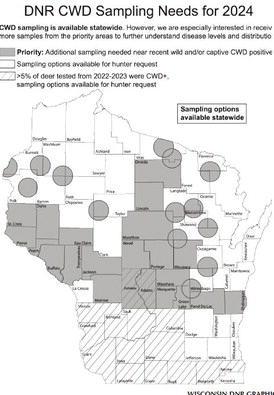Replacement tags


partners: Meat processors and other businesses can collect the deer head for sampling or remove the lymph nodes at the time of drop-off. This is a convenient option for hunters who intend to mount their deer. If a taxidermist is not a cooperator, ask for the caped-out head back to submit at a kiosk.
At-home lymph node extraction: Hunters may pick up a kit ahead of time, extract the retropharyngeal lymph nodes using the provided instructions and return the lymph nodes to the DNR or a kiosk for testing.
By appointment with local DNR staff: Hunters can contact their local wildlife management staff to schedule an inperson appointment.
If a hunter receives a CWD-positive test result, a replacement authorization will be issued to their Go Wild account within two to four days. A positive result from an antlered harvest authorization will result in a replacement antlered harvest authorization for the hunter (valid statewide).
New this year, if the positive result was received for an antlerless harvest registration, an either-sex replacement harvest authorization will be issued for the same DMU and land type.
The replacement authorizations aren’t weapon-specific and are valid for the remainder of the current hunting season and next year’s hunting seasons (starting in September 2025).
“Both of those types of authorizations would be added to a hunter’s GoWild account within two to four days of when the positive detection was received,” Larson said.
Proper disposal of deer carcasses can reduce the chance of CWD being introduced to a new area. Several disposal resources are available for hunters, including deer carcass disposal dumpsters, landfills or transfer stations. These options can be found on the DNR's CWD Sample and Disposal Locations map, and hunters are encouraged to check throughout the season, as more dumpsters will be added closer to the nine-day gun hunting season.
Hunters should check the DNR’s baiting and feeding webpage (https://dnr. wisconsin.gov/topic/hunt/bait) for the current feeding bans. There are several counties with new bans since last year’s hunting seasons, including Ozaukee, Pierce and St. Croix.
Taylor County remains in a ban through at least this year. All neighboring counties except Clark and Price also have baiting and feeding bans.
The DNR’s chronic wasting disease webpage (https://dnr.wisconsin.gov/topic/ wildlifehabitat/cwd) provides more information about baiting and feeding bans, testing options and disposal options.
The Wisconsin Department of Health Services (DHS), the Centers for Disease Control and Prevention and the World Health Organization all recommend against consuming meat from deer that test positive for CWD. Infected deer typically appear healthy for many months after contracting the disease, so DHS encourages testing for the disease regardless of the physical condition of the harvested deer, especially in areas prevalent with CWD. To date, there have been no reported cases of CWD infection in humans.
“CWD is a very slow progressing disease which makes it difficult (to see in live deer),” Larson said.
“These deer can be infected but look perfectly healthy.
There’s no way to know that they have CWD without that test until they start showing signs and those visual signs could be other types of disease or some sort of trauma that occurred. So that CWD test is really the way to tell that a deer is infected.
“Some of those common signs that show up and usually they’re not going to show up for at least a year and a half after a deer is infected could be extreme emaciation, a lower head, drooping ears, drooling, we’ve seen a deer that was visiting a land owner’s water bath for birds,” she added. “Sometimes we’ll see that where they’re trying to seek out water. Sometimes they’re not able to walk and could be looking pretty awful. They also will not act normal, they may not show that normal fear of humans that a healthy deer would.”
WISCONSIN DNR GRAPHIC
